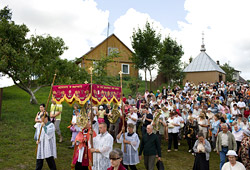Way of the Cross
Samogitian Calvary is the first example of a shrine representing the place of Christ’s Passion not only in the region of Samogitia but in all of what was then the Grand Duchy of Lithuania. Bishop Jurgis Tiškevičius is considered the founder of this Way of the Cross, while all the currently existing chapels there are thought to have been built around 1640. The place quickly became known for miracles and special graces. In 1843, a commission formed by the bishop to study the matter confirmed that the place was in fact famed for extraordinary divine interventions.
People contemplate the sufferings of Christ not only by praying the Stations of the Cross outdoors. During winter and Lent, devout souls often make the Ways of the Cross inside the Church of the Visitation, where there have long been pictorial stations. The side naves presently contain 20 images portraying the scenes from Christ’s Passion. Pilgrimages in procession through the hills of Samogitian Calvary have traditionally been arranged during Holy Week (and especially on Good Friday) and on feasts of the Holy Cross. Today the Way of the Cross devotion is led at the shrine one day each month (outside during summer, in the basilica during winter), although the largest crowds of pilgrims come for the annual feast on July 2–12.
The Way of the Cross at Samogitian Calvary is composed of 19 chapels which contain 20 stations (there are 2 stations in the seventh chapel). The chapels are spread out over a hilly part of the town, with architecture that is rather rustic and blends in naturally with the landscape. Large ornamental wall paintings embellish their interiors. The shapes of the chapels changed frequently between the 17th and the 20th centuries, so that sometimes it is hard to determine when they were built. This type of interior-focused chapels was typical at Polish “Calvaries” of the 17th and 18th centuries.
This Calvary can be divided into two parts. One part, the so-called Path of Christ’s Arrest, begins at the first chapel, known as “the Last Supper”, and ends at the tenth chapel, “the Praetorium”. The second part, referred to simply as the Way of the Cross, starts at “the Praetorium” and continues until the 19th and last chapel, “the Rediscovery of the Holy Cross”. Pilgrims start from the first chapel, then circle around, climb St John’s Hill and pass by the Cedron rivulet on their way back toward the first station. From there they go to the seventh chapel, which contains both the “Caiphus” and the “Prison” stations, then proceed toward the cemetery to Birch Hill and pass the eighth chapel, “Herod’s Palace”. After that they follow the Way of the Cross from “the Praetorium” to “Mount Golgotha”. The complicated route from one station to the next makes it difficult to make this Way of the Cross without a guide.








